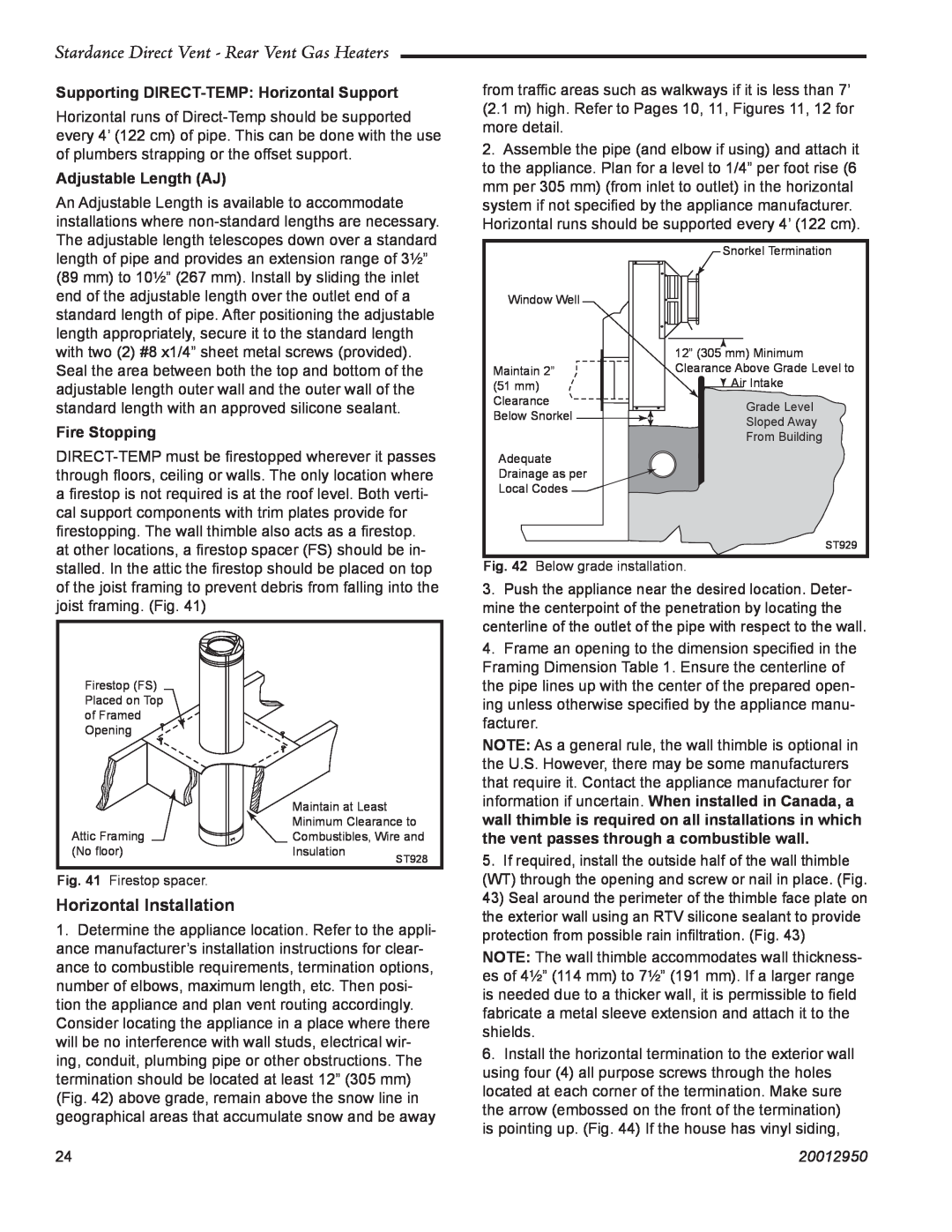
Stardance Direct Vent - Rear Vent Gas Heaters
Supporting DIRECT-TEMP: Horizontal Support
Horizontal runs of
Adjustable Length (AJ)
An Adjustable Length is available to accommodate installations where
Fire Stopping
from traffic areas such as walkways if it is less than 7’ (2.1 m) high. Refer to Pages 10, 11, Figures 11, 12 for more detail.
2.Assemble the pipe (and elbow if using) and attach it to the appliance. Plan for a level to 1/4” per foot rise (6 mm per 305 mm) (from inlet to outlet) in the horizontal system if not specified by the appliance manufacturer. Horizontal runs should be supported every 4’ (122 cm).
Snorkel Termination
Window Well
| 12” (305 mm) Minimum | |
Maintain 2” | Clearance Above Grade Level to | |
(51 mm) | Air Intake | |
Clearance | Grade Level | |
Below Snorkel | ||
Sloped Away | ||
| ||
| From Building | |
Adequate |
| |
Drainage as per |
| |
Local Codes |
| |
| ST929 |
Fig. 42 Below grade installation.
3. | Push the appliance near the desired location. Deter- |
mine the centerpoint of the penetration by locating the | |
centerline of the outlet of the pipe with respect to the wall. | |
4. | Frame an opening to the dimension specified in the |
Framing Dimension Table 1. Ensure the centerline of | |
Firestop (FS) Placed on Top of Framed Opening 
Attic Framing (No floor)
Maintain at Least Minimum Clearance to Combustibles, Wire and
Insulation ST928
the pipe lines up with the center of the prepared open- |
ing unless otherwise specified by the appliance manu- |
facturer. |
NOTE: As a general rule, the wall thimble is optional in the U.S. However, there may be some manufacturers that require it. Contact the appliance manufacturer for information if uncertain. When installed in Canada, a wall thimble is required on all installations in which the vent passes through a combustible wall.
5. If required, install the outside half of the wall thimble |
Fig. 41 Firestop spacer.
Horizontal Installation
1.Determine the appliance location. Refer to the appli- ance manufacturer’s installation instructions for clear- ance to combustible requirements, termination options, number of elbows, maximum length, etc. Then posi- tion the appliance and plan vent routing accordingly. Consider locating the appliance in a place where there will be no interference with wall studs, electrical wir- ing, conduit, plumbing pipe or other obstructions. The termination should be located at least 12” (305 mm) (Fig. 42) above grade, remain above the snow line in geographical areas that accumulate snow and be away
(WT) through the opening and screw or nail in place. (Fig. |
43) Seal around the perimeter of the thimble face plate on |
the exterior wall using an RTV silicone sealant to provide |
protection from possible rain infiltration. (Fig. 43) |
NOTE: The wall thimble accommodates wall thickness- es of 4¹⁄₂” (114 mm) to 7¹⁄₂” (191 mm). If a larger range is needed due to a thicker wall, it is permissible to field fabricate a metal sleeve extension and attach it to the shields.
6.Install the horizontal termination to the exterior wall using four (4) all purpose screws through the holes located at each corner of the termination. Make sure the arrow (embossed on the front of the termination) is pointing up. (Fig. 44) If the house has vinyl siding,
24 | 20012950 |
